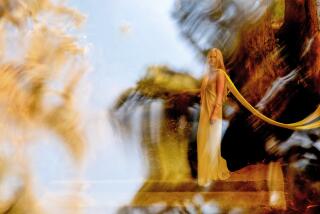Dreamtime by Hans Peter Duerr; translated by Felicitas Goodman (Basil Blackwell: $24.95; 462 pp.)
One of the chronic afflictions of Western education is its insistence on resolving contraries instead of embracing their simultaneous validity. Time can pass quickly and slowly at the same time. The truth can be a lie and a lie can be true. Logical language is able to comprehend the relativity that myth adores. Every Westerner has experienced the paradox but our schooling makes it hard for us to say we “know it.”
Hans Peter Duerr’s book is outstanding for its weirdness and provocation, even though its anthropology is neither original nor precise. Its 300 pages of footnotes are even more interesting than the 100-plus pages of text. “Dreamtime” celebrates the simultaneity of contraries at the crossroads of the logical and the mythic mind. “The ‘dream place’ is everywhere and nowhere, just like the ‘dreamtime’ is always and never.” It was, after all, predictable from the time when scientific specialization began in earnest early in this century that the most fascinating insights into the human mind and the culture it has left behind would occur wherever people observe two pathways crossing.
Readers of Graves’ “The White Goddess,” Butterworth’s “The Tree at the Navel of the Earth,” De Rougemont’s “Love in the Western World,” Fraser’s “The Golden Bough” or even of Carlos Castaneda’s powerfully conceived fantasies about Yaqui sorcery, will recognize familiar terrain here and may find it surprising that “Dreamtime” was a controversial best seller when it was first published in Germany in 1978. It offers nothing essentially new except the energy of its serendipity.
As he moves through space and time with the freedom of a comparative anthropologist with no loyalties to systematic logic, Duerr focuses amorphously on the premise that civilization proceeds most securely when it allows the boundaries between its own self-definition and the wilderness against which that definition is formed to be dissolved at least on an occasional routine basis. We ourselves “should turn wild so as not to surrender to our own wildness, but rather to acquire in that way a consciousness of ourselves as tamed, as cultural beings.”
Duerr’s study is in perfect sync with other contemporary explorations that insist that whether it be in the chemical bath of the brain’s neural network or in the study of psychotic disorders, the most fascinating interplay occurs on borderlines where limits are both defined and broken through: “Human societies, as we have seen, erected the fence between themselves and the wilderness in many ways, and this fence assumed a number of different meanings.”
Illustrating his loosely jointed argument, Duerr discovers or rediscovers provoking historical byways. Considerable documentation indicates that during the Middle Ages the courts were aware that women accused of witchcraft were often under the influence of hallucinogens; and that witches’ “flights” were explained by drugs. Duerr speculates that the legal system’s choice to ignore the chemical connection was made because of the Catholic Church: “If the sexual intercourse of the witch with the Devil or her dance at the witch’s sabbath turned out to be nothing but an illusion, then the next logical step would be the conclusion that the Devil himself was nothing but a phantom also.”
In “momboto” (as the Tolai tribe of New Brittany call dreamtime), “nhh” (ancient Egyptian) and “aradaga” (Germanic), everything turns upside down: “Humans behave ‘like wild animals,’ and men sleep with their sisters.” Pursuing inversions and reversals that occur at the borderlands of experience, Duerr spins off many tangents: fear of flying and the evaporation of ego boundaries; the transformation of the White Goddess or the huntress Diana into the Virgin Mary; werewolves (especially Chapter 6: “Wolves, death, and the island of ethnographers”); the Huichole practice of traveling back along their previous path compared to the Tantric Holy Men who walk against the current by “causing all life process, from breathing to the flow of semen to go ‘backwards’ ”; the eroticization of the late Middle Ages.
Duerr traces the interwoven cross-cultural leitmotif in Teutonic mythology of the world tree Yggdrasil, St. Peter’s upside-down cross, and the axis of the world and its relationship to Noon: The magician climbs down the tree into various worlds, just as Buddha sat under the tree to see many visions in heaven. “Its roots reach into the lower world, its top stretches to the upper world, and humans live around the middle section of its trunk. Ijakyl, the ‘animal mother of shamans,’ lies among the roots. She swallows the shaman’s soul and gives birth to it in animal shape. From that day forward, the shaman possesses ‘another side’ of his person, his ‘animal part’ . . . which lives out in the taiga (or steppe) in a lonely tree.”
Despite its patches of brilliant illumination, Duerr’s book is an obscure essay on the human experience. “Dreamtime” is a flavored popcorn approach to nutrition--more an anthropological adventure than a momentous study, entertaining the palate without sticking to the bones.
More to Read
Sign up for our Book Club newsletter
Get the latest news, events and more from the Los Angeles Times Book Club, and help us get L.A. reading and talking.
You may occasionally receive promotional content from the Los Angeles Times.






